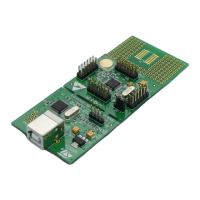Universal asynchronous receiver transmitter (UART) RM0016
326/449 Doc ID 14587 Rev 8
22.3.9 UART synchronous communication
The UART transmitter allows the user to control bidirectional synchronous serial
communications in master mode.
In synchronous mode, the following bits must be kept cleared:
● LINEN bit in the UART_CR3 register
● SCEN, HDSEL and IREN bits in the UART_CR5 register
Note: This feature is only available in UART1 and UART2.
The UART_CK pin is the output of the UART transmitter clock. No clock pulses are sent to
the UART_CK pin during start bit and stop bit. Depending on the state of the LBCL bit in the
UART_CR3 register clock pulses will or will not be generated during the last valid data bit
(address mark). The CPOL bit in the UART_CR3 register allows the user to select the clock
polarity, and the CPHA bit in the UART_CR3 register allows the user to select the phase of
the external clock (see Figure 121, Figure 122 & Figure 123).
During idle and break frames, the external CK clock is not activated.
In synchronous mode, the UART receiver works differently compared to asynchronous
mode. If RE=1, the data is sampled on SCLK (rising or falling edge, depending on CPOL
and CPHA), without any oversampling. A setup and a hold time (even if the hold time is not
relevant due to the SPI protocol) must be respected (which depends on the baud rate: 1/16
bit time for an integer baud rate).
Note: 1 The UART_CK pin works in conjunction with the TX pin. When the UART transmitter is
disabled (TEN and REN= 0), the UART_CK and UART_TX pins go into high impedance
state.
2 The LBCL, CPOL and CPHA bits in UART_CR3 have to be selected when both the
transmitter and the receiver are disabled (TEN=REN=0) to ensure that the clock pulses
function correctly. These bits should not be changed while the transmitter or the receiver is
enabled.
3 It is recommended to set TE and RE are set in the same instruction in order to minimize the
setup and the hold time of the receiver.
4 The UART supports master mode only: it cannot receive or send data related to an input
clock (SCLK is always an output).
5 The data given in this section apply only when the UART_DIV[3:0] bits in the UART_BRR2
register are kept at 0. Else the setup and hold times are not 1/16 of a bit time but 4/16 of a
bit time.
This option allows to serially control peripherals which consist of shift registers, without
losing any functions of the asynchronous communication which can still talk to other
asynchronous transmitters and receivers.

